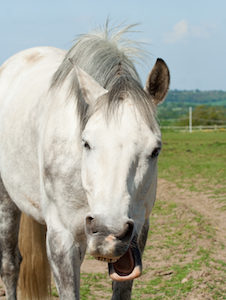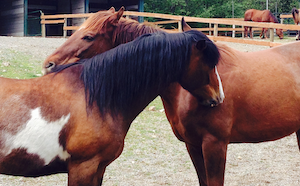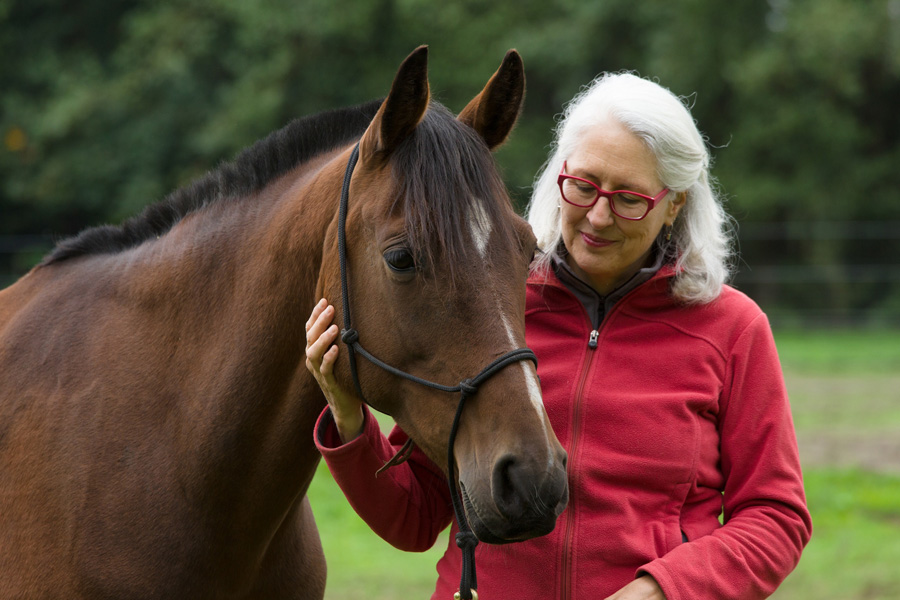How to Speak Horse
by Barbara Breckenfeld, LAMP

Have you looked at a horse and wondered what they were thinking? Horses’ body language offers some insights.
Horses use a wide variety of gestures made with their body, face, ears, tail, sounds, and movement. When we learn and use horse signals, we increase our connection with our horses, and help them feel calmer and safer around us.
Horse people learn to recognize threatening actions like pinned ears, bared teeth, a hard eye, a threatening foot, snaking, striking, or a squeal. Horses also use subtle gestures for calming. Here, we’ll focus on body language used to de-escalate an interaction and to release tension.
To start, horses’ brains are different from ours. Wired as prey and herd animals, horses are acutely sensitive to their environment close up and at distance. Their survival depends upon not appearing vulnerable, and they instinctively avoid showing weakness. Thus, subtle changes in body language have meaning. When we ignore subtle communication, horses will “speak” more and more obviously until we get the message (a kick, bite, or bucked off).
Temple Grandin reminds us that horses are sensory-based thinkers; they think in pictures, feelings, sounds, and smells. Their motivations as well as their brains work differently from humans. They are more troubled by fear than by pain, and hide their pain to survive. Context and knowing the individual are key to understanding what they are communicating.
During bodywork, we observe many signs of release: licking and chewing, snorting or sneezing, shaking the body, yawning, stretching, rolling back the second eyelid (especially during yawning), fidgeting (when the horse is about to release). Subtle signs include a shift of weight or change in breathing—holding it or speeding up. There are even subtler signs such as blinking, quivering lips, sighing, dropping the head, softening the eye or face that can indicate deep processing. Outside of bodywork, these indicate a release of tension with an intent towards calmness.
Turgid Rugaas, a Norwegian dog trainer, has observed body language in dogs she calls “calming signals.” These are ways that dogs show that they mean no threat. Anna Blake adopted this phrase for similar expressions in equine body language. It’s a helpful term.
Horses use calming signals to say they are not a threat to us or to another horse. Gestures include: head turning away, softening eyes, yawning, licking and chewing, snorting and blowing, walking in a curve, and clacking or champing (with low head and neck that mimes nursing, grooming or grazing) used to appease or self-soothe.

Speaking Better Horse
Let’s remember how sensitive horses are—700 times more than humans. Not only do they feel a fly, but their hearing, smell, and sight evolved to track their environment at a vast distance.
What’s a mere human to do?
Assume that everything a horse does is communication, and our job is to understand what they are saying. When we successfully respond to their body language, the horse feels safer, calmer, more relaxed. When we respond to their subtle signals, we gain their cooperation and avoid escalation.
Like any good conversation, we can listen and watch with curiosity, have a quiet mind, without projecting human attributes onto them. Be present. Observe the horse’s posture overall. Does she appear tense, uncomfortable or worried, irritated or angry? Is the upper eyelid wrinkled or relaxed? Is the tail clamped or the nostrils flared? A swishing tail can be flies or irritation; swinging hindquarters may be stepping away or it may be a warning before a kick.
Here are a few ways to use equine body language to show our horses that we are not threatening. Slow down our movements, pause often, talk softly—if at all. Breathe slowly and deeply. Compared to horses, we are predators who talk loudly and make sudden, harsh movements.
When approaching, walk in a curved line, or a zigzag, not directly to them. If you’re in a field, pause and exhale, stop to examine a pebble. Approach their side with your side instead of straight on. When haltering, if the horse turns their head away or walks away, just pause, breathe, and wait for them to turn back. During grooming, tacking up, and handling go slower and softer, pause more often and exhale. Enjoy spending time and growing the connection with your horse.
Originally Published March 2018 Issue

Barbara Breckenfeld of Movement in Balance does equine bodywork/massage and healing in the greater Puget Sound area, as well as offering her popular “Bodywork for Horses” clinics. She is nationally certified by NBCAAM, licensed as a Large Animal Massage Practitioner (LAMP) in Washington State, and an Equine Structural Integration Practitioner certified by the Equine Natural Movement School. Barbara became a horsewoman in 1993 when a handsome dapple-gray won her heart and introduced her to the fundamentals of dressage. Contact Barbara by email [email protected], call 425-260-0784, or visitwww.movementinbalance.com.






